Having escaped the Underworld, traversed the Overworld, and ascended through the Skyworld, Pit at last arrives at Palutena’s palace. And once again, the game changes formats… though this time it’s a far more radical transformation. The three treasures you’ve wrested away from the fortress bosses (the mirror shield, the wings of Pegasus, and the arrow of light) allow you to enter the Sky Palace and take on Medusa.
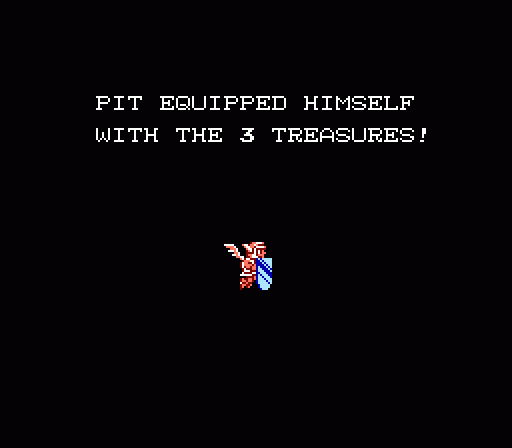
The arrow can slay the Gorgon, the mirror shield will reflect her petrifying gaze, and the wings? They transform Kid Icarus from a platformer into a shoot-em-up.
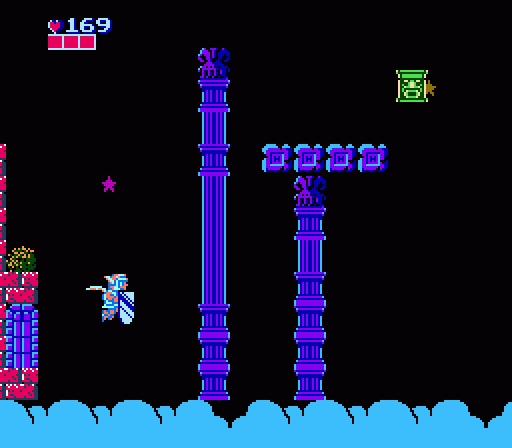
The final stage of Kid Icarus doesn’t so much represent a change in style as it does a complete shift of genre. Whatever else you want to say about Kid Icarus, this was a pretty crazy move. You didn’t really see a lot of multi-modal games at this point in history, and the ones that did come along (Tron, for instance) generally were presented explicitly as such. Kid Icarus‘ shifts are more subtle than that, and the rules don’t really change from one part of the game to another. You’re playing in a different style here than you did in the previous 12 stages, yes, but it feels more consistently, as if taking flight were simply the logical extension of how you’ve been playing so far.
It helps that there is some limited flight throughout the earlier portions of the game, optionally. If Pit falls off the screen while holding a Feather, he’ll have about six seconds of air time to allow him to wing his way back up to safety — or, if you’re really devious about it, past a particularly tricky series of jumps. Taking flight permanently simply reworks that minor feature into the core action, giving you a much better weapon in the process (the arrow of light pierces foes and can cut through an entire four-enemy wave with a single well-placed blast).
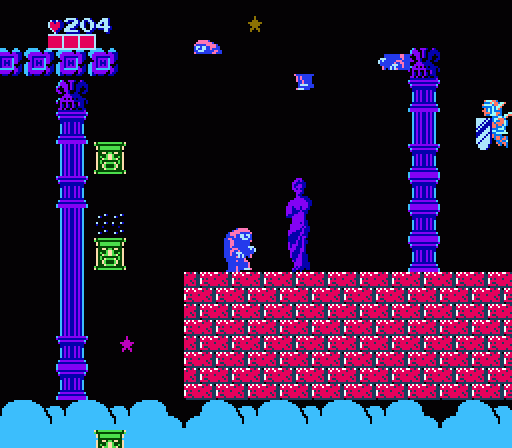
This also extends Kid Icarus’ ridiculously inverted difficulty curve to its logical extent. This final stage is as toothless as the first level is brutal. Enemies pose the only hazards here, and most of them approach in simple, predictable waves. You will meet occasional foes that pose a slightly greater threat, like these one-eyed guys (who, I just realized, appear to be skeletal or zombie versions of Eggplant Wizards). Their bodies materialize by flying in from off-screen in three pieces, settling on the wall and firing quick projectiles at you.
But that’s about as dangerous as it gets. Even the scenery poses no threat; you don’t have to worry about collisions with walls or the floor, because everything here is simply a background element. The screen scrolls automatically at a fairly slow rate, and you can move freely about to any point on the screen. If you’ve taken the time to pump up your health to the maximum available (five bars) you practically have to go out of your way to lose here.
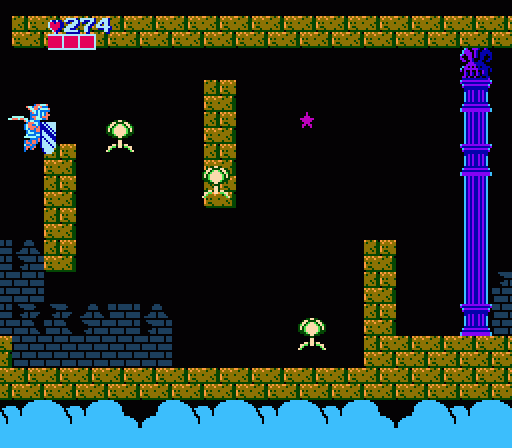
Of course, it just wouldn’t be Kid Icarus if you didn’t have to contend with invisible, not-entirely-intuitive game parameters. Palutena’s palace will continue to loop infinitely, sending you past the same scenery and threats in an endless circle, until you shoot enough enemies. Only after your score reaches a certain point will the loop break, sending you to the final showdown with Medusa. This isn’t actually communicated anywhere in the game, and players trying to take a conservative approach by finding a safe spot out of the way and hovering there will eventually wonder why the game just keeps going and going….
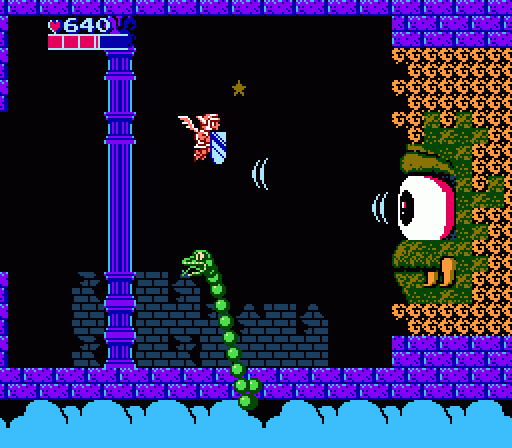
When at last you do reach Medusa, Kid Icarus brings another Metroid connection into play. The final boss here, like Mother Brain, is female. She exists as a large, stationary piece of scenery. She has a single massive eye, which also doubles as her weak point. And she’s defended by smaller, infinitely spawning companion creatures.
That being said, Medusa has nothing on Mother Brain. That battle is downright nasty, flinging threats at you as you struggle to maintain your purchase on the single tiny perch from which you can attack without being knocked into magma. Here, Medusa fires a handful of eye beams (easily dodged) while snakes attack in a sine wave pattern (what is it with Medusa and sine waves, anyway?). It’s a pretty low-threat scenario, and you can pump her eyeball full of arrows with little trouble.
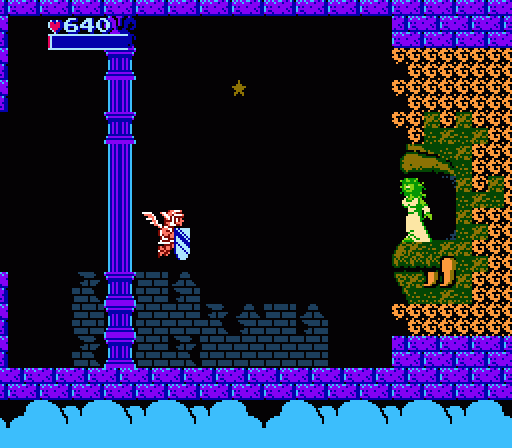
Eventually, Medusa is revealed to be a Wizard of Oz-like façade hiding the true Gorgon, who it appears in truth is a green, busty, one-eyed naga. She collapses, and the temple begins to explode! Time bomb set — you have 100 seconds to escape.
Just kidding. There’s none of that Metroid challenge here. Once Medusa goes down, the game is over.
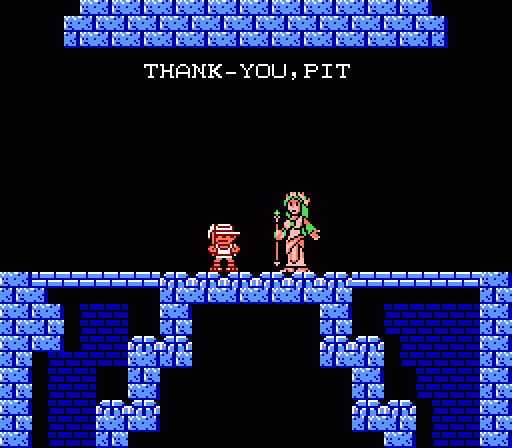
You do get one final Metroid connection, though, for posterity. The ending you receive from Palutena is based on your performance. As mentioned before, time doesn’t factor in here; your reward is based on your character parameters: Strength, health, possession of sacred weapons, and cash. The more of those factors you manage to max out, the better your ending. Max out none of them and Pit apparently becomes demoted to working as a farmer, or something.
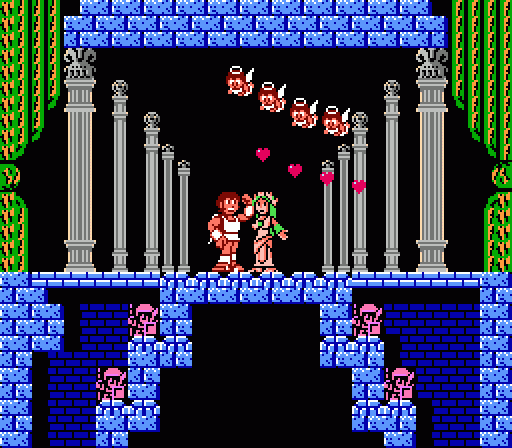
Hit the limit with them all, however, and you get a rather elaborate colonnade backdrop as Pit suddenly leaps straight past puberty and into a adulthood for a makeout session with the goddess. Don’t do it, Pit! Sure, she’s beautiful, but sexing up members of the Greek pantheon never brought anything but tragedy upon anyone.
You can also start again after finishing the game with a New Game + mode that lets you carry all your gear into a second playthrough. It’s deeply satisfying to tear through that accursed first level with a Pit who’s loaded for bear. However, in the inimitable Kid Icarus style, this comes with a tragic flaw: If you simply collect a password in World 1-1 on the second go ’round, it won’t record your upgrades. You have to make it World 1-2 again to be able to save that element of your progress. Idiotically, this flaw carries over into the 3D Classics version… the downside there being that the game auto-saves your adventure, so there’s no reverting back to the World 4-1 password. As I discovered the hard way while writing this series. Screw you, Kid Icarus.
So, that’s Kid Icarus in a nutshell. A weird game to be sure, much less polished than its peers despite being considerably less ambitious than Metroid. You can tell that the creators had a lot of big ambitions, changing up the play style and telling a sort of story with the scenery, but those efforts didn’t pan out nearly as well as in its contemporary, Castlevania. Kid Icarus starts hard and gradually becomes easier, which makes for a second half that’s barely memorable because (1) you’ve seen it all before and (2) you can breeze past the later stages with far greater ease than the difficult early levels. On the plus side, the freewheeling final stage makes quite a carrot. It may be an uneven adventure at best, but it ends on a high note… so anyone who bothers to make it that far at least gets to go away feeling happy.
Next time: We shrug off the shackles of 8-bit oppression and look to the future (well, the future circa the early ’90s, anyway).
Man, I know exactly what you mean about the game’s fatal New Game Plus flaw. I beat the game on 3D Classics Kid Icarus then chose to save and quit at the start of the second run. -_-; I got the soldier ending, BTW.
Speaking of the ending, I found this out by Rey a while back, but if you do a minimalist run in the Japanese version Pit gets the upper half of his body turned into a Specknose in the ending. Dunno if it’s in the 3D Classics version, but considering it’s based more on the Famicom Disc System game it might be.
I enjoyed this series, even if the game itself is flawed. It’s just a weird example of design matching the story content of the game, but creating an unsatisfying player experience as a result. I’d definitely be interested in more anatomies of games that don’t “work” (for lack of a better term), but maybe just a single article highlighting them if it has such a negative impact on traffic or if they don’t merit level by level analysis.
Looking forward to the next series, thanks again for the informative reads.
“Next time: We shrug off the shackles of 8-bit oppression and look to the future (well, the future circa the early ’90s, anyway).”
Excellent. I can’t wait for an in-depth discussion of the Virtual Boy and its storied pantheon of game design.
I still find it kinda weird Nintendo stuck with “Palutena” instead of “Palthena.” I mean, both names work when you translate from katakana, but considering the Greek mythology angle you’d think they originally meant the goddess to be named Palthena, after Pallas Athena (which you could creatively shorten to Paru Tena in Japanese).
Anyway, it’s an interesting game, if deeply flawed. Good to see you stuck with it to the end.
You should mention that in the Japanese version, Pit gets turned into a specknose in the worst ending, which to me is actually the best ending. Too bad it was removed for the USA version.
http://www.vgmuseum.com/end/fds/a/hipalutena.htm
Ah, I have a good guess on the next one, too!
Do you plan to put the Kid Icarus articles in a book, Jeremy? Metroid’s, perhaps?
Great write-up, Jeremy. I wanted to write this on the World 2 summary, but comments were closed by the time I got to it:
Being that this game was so brutally hard when I was a kid, eventually my favorite way to play it was to input the ICARUS FIGHTS MEDUSA ANGELS password which puts you at 2-4 with eight barrels, 99 feathers, max arrow strength & health; it’s basically impossible to lose at that point, though you can still get lost in the fortresses (or worse, blunder into the boss room while Eggplanted). I believe that code also starts you out with two out of the three optional power-ups, but via some weird glitch you can acquire the third one (the rotating shield) by heading into the healing pool at the beginning of 3-1 (or maybe 3-2) and waiting for it to refill your health.
A lot of times I’d just finish the game that way and have at it, but sometimes I’d go through the New Game+ and kick ass all the way through that nasty underground world and so on. It’s an arguably dishonorable, but highly gratifying play method. I’d recommend it for anybody who finds playing the game “normally” to be overly frustrating. You can experience its charms while skipping (most of) its problems.
@The Sprat: Ain’t no shame in playing tourist through a frustrating game. I got to the jumping part of Turok on N64 and decided “screw it,” so my roommates and I unlocked all the weapons and god knows what else and dicked around with the game for a few hours before trading it in.
Also, I don’t think the third weapon’s appearance is a glitch. For each weapon you acquire, your health needs to be above a certain threshold to activate it, and dungeons don’t count. So my guess is that code registers the last weapon as having been acquired in 2-3 with insufficient health for it to trigger, and the pool in 3-1 puts you over the minimum. The more you know!
I too think that there should be examples of “bad” game design for the anatomy series, but like Tato wrote limit it to a few paragraphs or a single entry. If we are traveling to the 90’s do we ever get to encounter the Genesis perhaps?
Parish: Ah, cool, I didn’t know that! All this time I just assumed it was a glitch or some hidden feature of that password. Weird that it “activates” at a certain HP threshold, but doesn’t seem to disappear once you go below that threshold. This game is just eccentricities all over.
I also was nuts over the idea of freeing as many centurions as possible when I was young, even though the help they provided at boss time was usually slight at best. It’s just such a fun idea.